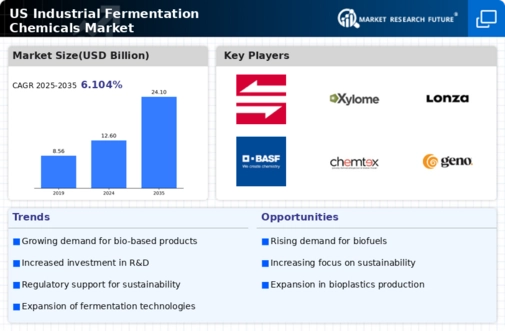The industrial fermentation chemicals market is characterized by a dynamic competitive landscape, driven by increasing demand for sustainable and bio-based products. Key players such as DuPont (US), Cargill (US), and BASF (US) are actively engaged in innovation and strategic partnerships to enhance their market positions. DuPont (US) focuses on developing advanced fermentation technologies, while Cargill (US) emphasizes its commitment to sustainability through investments in bio-based chemical production. BASF (US) is leveraging its extensive research capabilities to create novel fermentation processes, thereby contributing to a more sustainable chemical industry. Collectively, these strategies foster a competitive environment that prioritizes innovation and sustainability, shaping the future of the market.
In terms of business tactics, companies are increasingly localizing manufacturing to reduce supply chain vulnerabilities and enhance responsiveness to market demands. The market structure appears moderately fragmented, with several key players exerting significant influence. This fragmentation allows for a diverse range of products and innovations, while also intensifying competition among established firms and new entrants alike.
In November 2025, DuPont (US) announced a strategic partnership with a leading biotechnology firm to develop next-generation fermentation processes aimed at producing high-value chemicals from renewable resources. This collaboration is expected to enhance DuPont's capabilities in sustainable production, aligning with the growing consumer preference for eco-friendly products. The strategic importance of this partnership lies in its potential to accelerate innovation and expand DuPont's product portfolio in the fermentation chemicals sector.
In October 2025, Cargill (US) unveiled a new facility dedicated to the production of bio-based chemicals derived from agricultural feedstocks. This facility is part of Cargill's broader strategy to localize production and reduce its carbon footprint. The establishment of this facility not only strengthens Cargill's position in the market but also reflects a growing trend towards integrating agricultural resources into chemical production, thereby enhancing sustainability.
In September 2025, BASF (US) launched a new line of fermentation-derived products aimed at the food and beverage industry, showcasing its commitment to innovation. This launch is significant as it highlights BASF's ability to respond to market trends and consumer demands for natural ingredients, further solidifying its competitive edge in the industrial fermentation chemicals market.
As of December 2025, current competitive trends indicate a strong emphasis on digitalization, sustainability, and the integration of artificial intelligence in production processes. Strategic alliances are increasingly shaping the landscape, enabling companies to pool resources and expertise to drive innovation. Looking ahead, competitive differentiation is likely to evolve from traditional price-based competition to a focus on technological advancements, sustainability, and supply chain reliability. This shift underscores the importance of innovation as a key driver of success in the industrial fermentation chemicals market.





















Leave a Comment